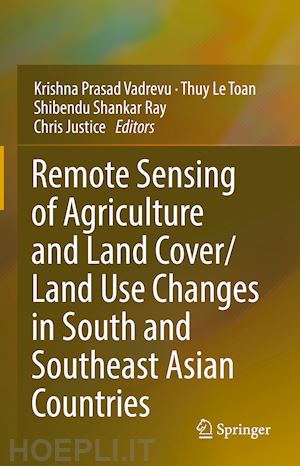
Questo prodotto usufruisce delle SPEDIZIONI GRATIS
selezionando l'opzione Corriere Veloce in fase di ordine.
Pagabile anche con Carta della cultura giovani e del merito, 18App Bonus Cultura e Carta del Docente
This book sheds new light on the remote sensing of agriculture in South/Southeast Asian (S/SEA) countries. S/SEA countries are growing rapidly in terms of population, industrialization, and urbanization. One of the critical challenges in the region is food security. In S/SEA, although total food production and productivity have increased in previous decades, in recent years, the growth rate of food production has slowed down, mostly due to land use change, market forces and policy interventions. Further, the weather and climate systems in the region driven primarily by monsoon variability are resulting in droughts or flooding, impacting agricultural production. Therefore, monitoring crops, including agricultural land cover changes at regular intervals, is essential to predict and prepare for disruptions in the food supply in the S/SEA countries.
The current book captures the latest research on the remote sensing of agricultural land cover/ land use changes, including mapping and monitoring crops, crop yields, biophysical parameter retrievals, multi-source data fusion for agricultural applications, and chapters on decision making and early warning systems for food security. The authors of this book are international experts in the field, and their contributions highlight the use of remote sensing and geospatial technologies for agricultural research and applications in South/Southeast Asia.
Dr. Krishna Vadrevu is the Deputy Program Manager for the Land Cover/Land Use Change (LCLUC) Program at the Earth Science Division of NASA's Science Mission Directorate. He is also leading the South/Southeast Research Initiative (www.sari.umd.edu), a regional initiative of the NASA LCLUC program. He has more than 20 years of research experience in satellite remote sensing. Dr. Vadrevu gained his Ph.D. in 2000 while working at the Indian Space Research Organization (ISRO), India. He worked with the interdisciplinary team of agricultural scientists at the Ohio Agricultural Research and Development Center (OARDC), the Ohio State University, USA, on remote sensing of agroecosystems and organic farming field experiments (2001-2010). He then focused on various LCLUC projects, including vegetation fires in developing countries at the University of Maryland, College Park (2010-2016). He joined NASA in 2016. Dr. Vadrevu served as PI and Co-I on projects funded by NASA, USDA, and NSF on LCLUC, biomass burning/greenhouse gas emissions, land-atmospheric interactions, agricultural carbon cycling, and ecosystem sustainability. He has more than a hundred publications in peer-reviewed journals and books.
Dr. Thuy Le Toan is the Head of the research team in Remote Sensing in the Center for the Study of the Biosphere from Space (CESBio), a joint research Centre of the University of Toulouse, the National Center of Scientific Research (CNRS), and the National Center of Spatial Studies (CNES), France. Her current interest is on the use of Radar Earth Observation data to monitor terrestrial ecosystems, focusing on their role in the carbon budget and climate change, particularly in the tropics. She is P.I. of the ESA Biomass mission and currently Co-chair of the Biomass Mission Advisory Group. Moreover, she has been co-lead of the Asia-Rice Initiative. Also, she is currently involved in projects on forest biomass and rice agriculture and the effects of climate change on these ecosystems. She has supervised numerous Ph.D. students and post-doc researchers at the University Paul Sabatier, Toulouse, France, and international collaboration in Europe, the U.S., and Asia. In addition, she has been lecturing and conducting training courses on SAR Remote Sensing at Universities and Research organizations in Europe, South America, and many countries in Asia.
Dr. Shibendu Shankar Ray was the Director of the Mahalanobis National Crop Forecast Centre, Ministry of Agriculture & Farmers' Welfare, India. He worked for more than 20 years in the Space Applications Centre, Indian Space Research Organization (ISRO) on Remote Sensing Applications in Agriculture. He led a team of scientists and researchers on various national-level operational agricultural applications, including Crop Forecasting, Drought Assessment, Crop Insurance, Horticultural Assessment and Development, and Crop Intensification. His sudden demise on May 04th, 2021, extremely saddened us. Although he was a co-Editor in this book project, unfortunately, he couldn't see the project to fruition.
Dr. Christopher Justice is a Professor at the Department of Geographical Sciences, University of Maryland, College Park, USA. He has 40 years of research experience in remote sensing. His current research is on land cover and land-use change and global agricultural monitoring using remote sensing. He is the Chief Scientist for NASA HARVEST, NASA's Applied Sciences program on agricultural monitoring. He serves as Project Scientist for the NASA LCLUC Program, the Land Discipline Lead for the NASA MODIS, and the Suomi-NPP VIIRS Science Team. In addition, he is the Co-Chair of the international GEO Global Agricultural Monitoring Initiative (GEOGLAM), and Chair of the international Global Observations of Forest and Land Use Dynamics (GOFC-GOLD) program.











Il sito utilizza cookie ed altri strumenti di tracciamento che raccolgono informazioni dal dispositivo dell’utente. Oltre ai cookie tecnici ed analitici aggregati, strettamente necessari per il funzionamento di questo sito web, previo consenso dell’utente possono essere installati cookie di profilazione e marketing e cookie dei social media. Cliccando su “Accetto tutti i cookie” saranno attivate tutte le categorie di cookie. Per accettare solo deterninate categorie di cookie, cliccare invece su “Impostazioni cookie”. Chiudendo il banner o continuando a navigare saranno installati solo cookie tecnici. Per maggiori dettagli, consultare la Cookie Policy.